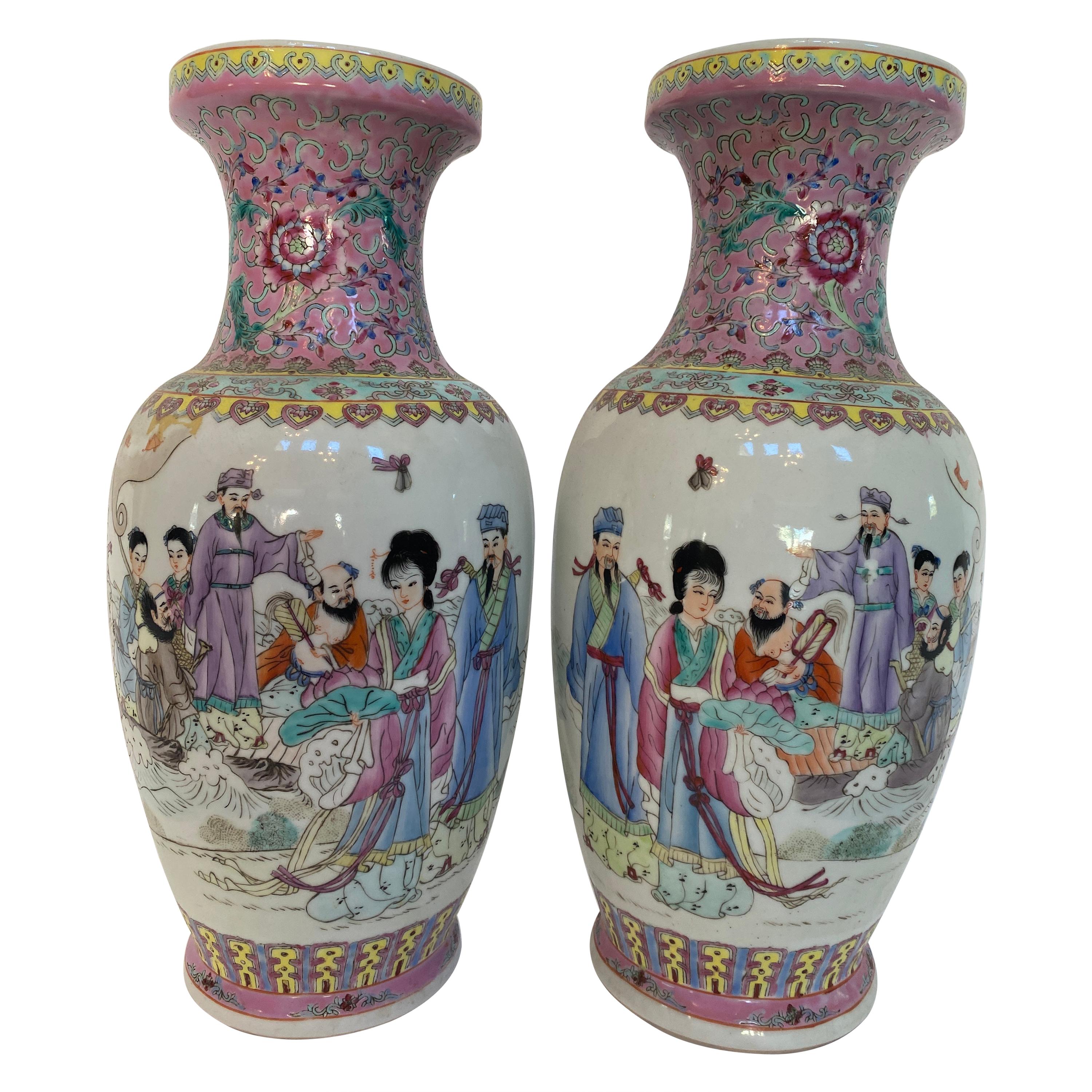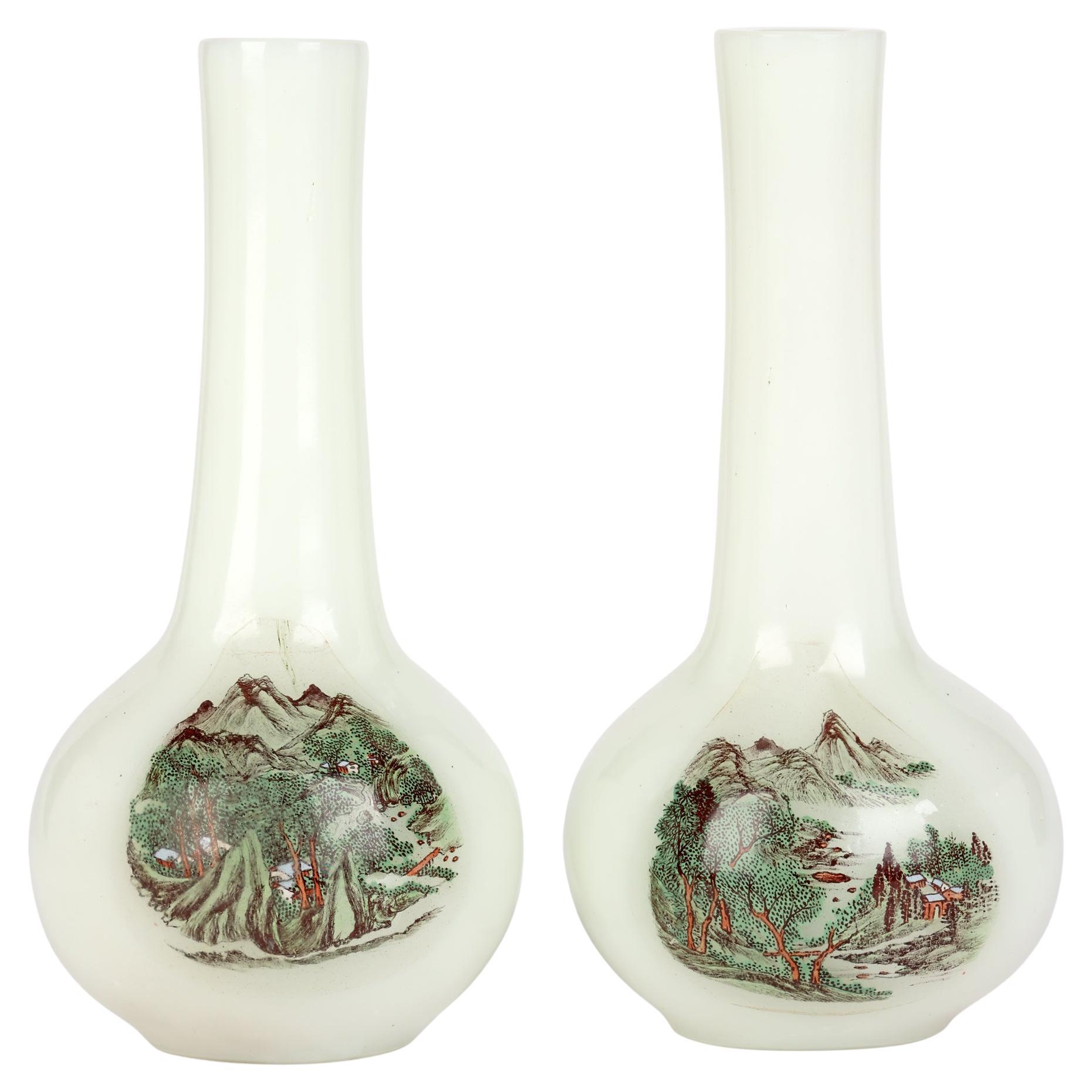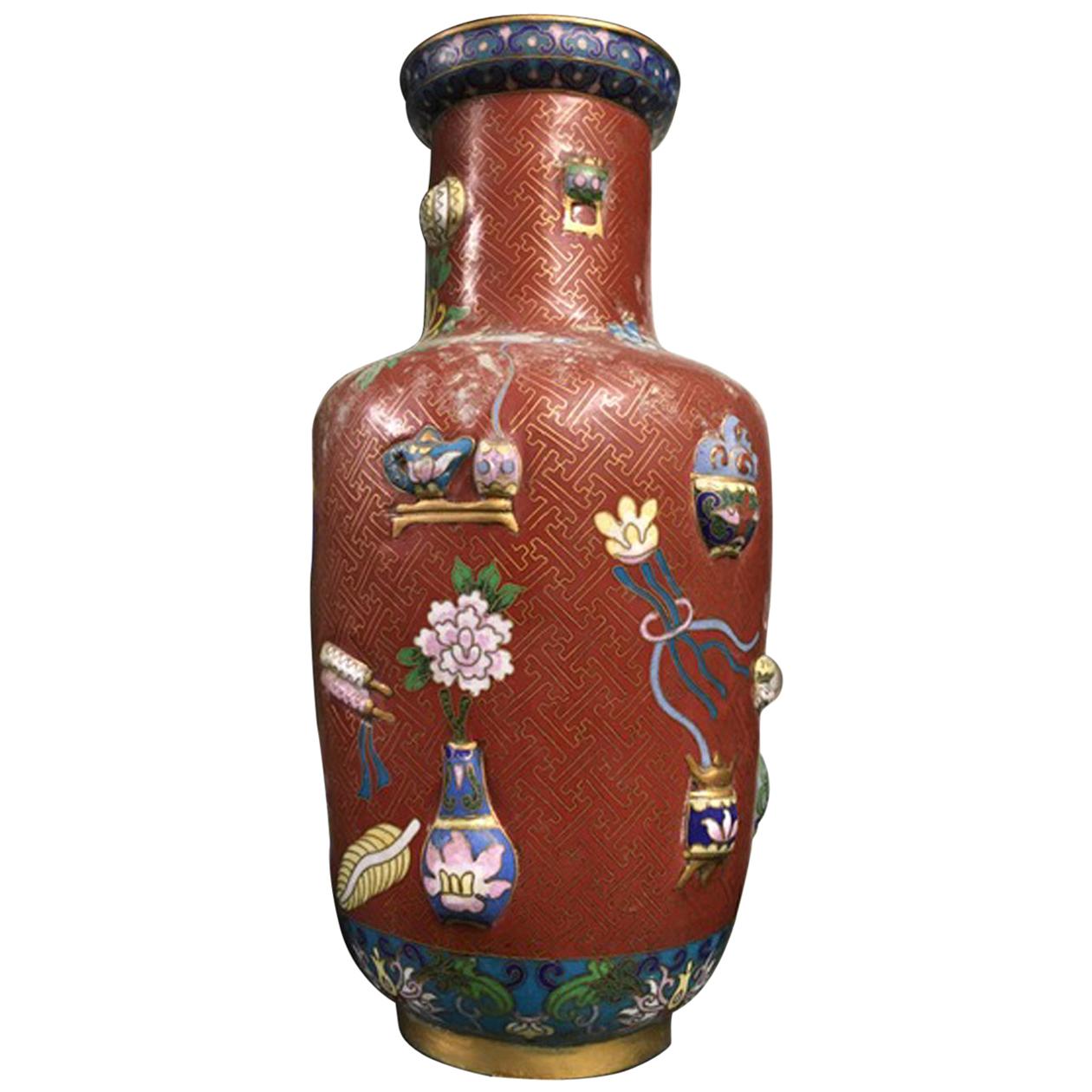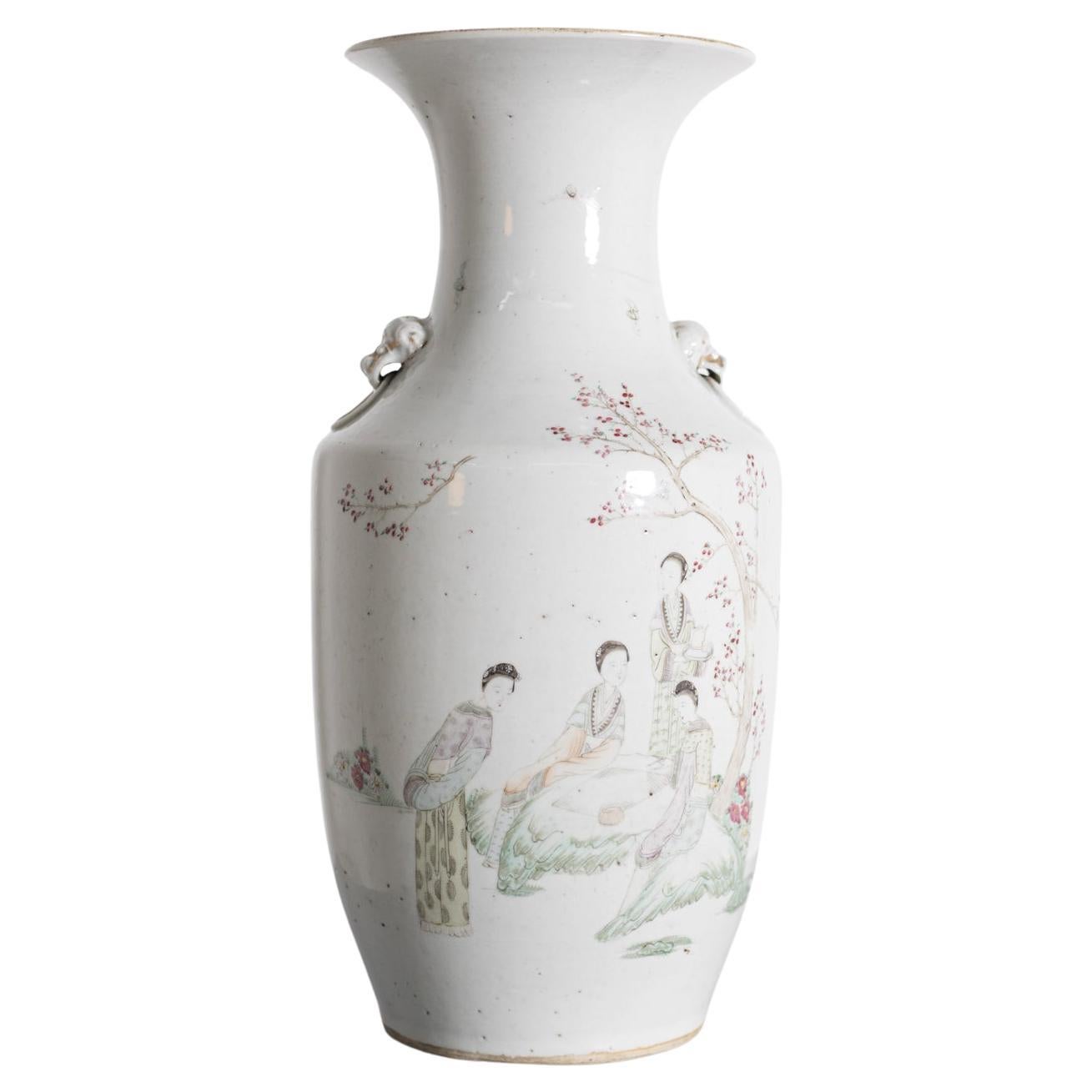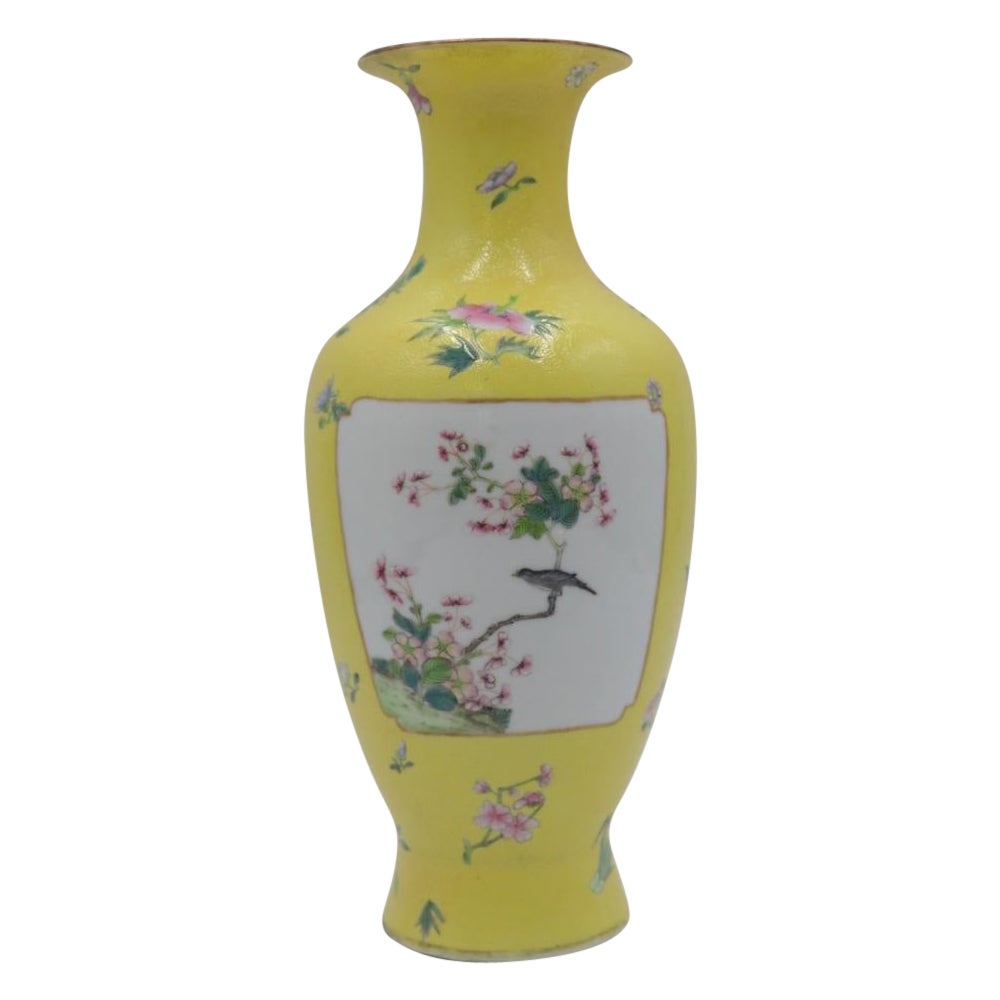Items Similar to China Republic 1912-1960 Inside Paint Carved Rock Crystal Vase Silver & Enamel
Want more images or videos?
Request additional images or videos from the seller
1 of 14
China Republic 1912-1960 Inside Paint Carved Rock Crystal Vase Silver & Enamel
About the Item
An impressive China inside-painted vase in rock crystal.
Beautiful and one-of-a-kind art-piece. created in China during the first years of the China-republic, circa 1912-1949. This cushion shaped vase with a lid, has been carefully carved, with elaborated details from four-pieces of natural translucent rock crystal and embellished, with inside-painted scenes of the Chinese Imperial court, probably from the Ming dynasty.
The images are divided into four-panels. The main ones depicts, the Chinese Emperor enthroned, with courtesans around and the standing figure of the Empress surrounded by servants. The secondary two small side panels depicts, two groups of courts ladies.
The piece is embellished in the outside, with intricate filigree mountings crafted of gilded .800/,999 sterling silver. The sterling mounts pieces are decorated, with applications of color enamels and small beads of natural blue turquoises.
In the Empress panel, on top at left, are a poem inscribed in Chinese characters (need to be translated) in black ink and the maker's signature in red ink,
The top lid is decorated with the same technique, depicting two painted paradise birds and one bead of 12 mm carved from translucent reddish agate.
This piece have an overall measures of 175 mm by 125 mm by 250 mm (6.90 x 4.95 x 9.83 Inches).
Inner-painting, is also known as inner drawing or inside painted, is a very difficult Chinese art form. It involves glass bottles which have pictures and often calligraphy painted on the inside surface of the glass. The bottles and vases are produced by manipulating a specialized paint brush through the neck of the bottle.
Inside-painted bottles are associated with Chinese snuff bottles. The earliest inside painted bottles are thought to have been made in the period between 1820 and 1830 as, by then, the beauty of a snuff bottle was probably more important than utilitarian considerations -and considering this- few would have been used for holding snuff.
To paint the inside of the bottle, the artist must paint backwards. Concentration is crucial to make precise strokes. A skilled artist may complete a simple bottle in a week while something special may take a month or more. The best craftsmen may produce only a few bottles in a year.
Note: Painting on the inside of a miniature container is challenging, especially when the motifs can be as intricate as landscapes, insects, and human figures. The technique had been guarded as a secret of the industry and not disclosed to the public until the end of the last century.
Literature: The amazing art of "inside painting", Chen Huizhi, Shanghai Daily, August 15, 2016.
Very rare and impressive vase in great antique condition, with just one small sphere missing.
INVENTORY REF: D0000XINM/.1111.
- Dimensions:Height: 9.83 in (24.97 cm)Width: 4.95 in (12.58 cm)Depth: 6.9 in (17.53 cm)
- Sold As:Set of 2
- Style:Chinese Export (Of the Period)
- Materials and Techniques:
- Place of Origin:
- Period:
- Date of Manufacture:circa 1912-1945
- Condition:Wear consistent with age and use. Very rare and impressive vase in great antique condition, with just one small sphere missing.
- Seller Location:Miami, FL
- Reference Number:
About the Seller
5.0
Platinum Seller
These expertly vetted sellers are 1stDibs' most experienced sellers and are rated highest by our customers.
1stDibs seller since 2023
63 sales on 1stDibs
Typical response time: <1 hour
- ShippingRetrieving quote...Ships From: Miami, FL
- Return PolicyA return for this item may be initiated within 1 day of delivery.
More From This SellerView All
- China 618-907 AD Tang Dynasty Offering Vessel With 8 Lotus Petals in EarthenwareLocated in Miami, FLOffering vessel from the Chinese Tang Dynasty (618-907 AD). A beautiful "offering spiritual vessel" from the Yunnan province region in the ancient China. This was created in clay earthenware pottery during the Tang Dynasty period between the 618 and 907 AD. Featuring finely molded patterns with incised and high reliefs of geometric figures. The design consists of the bombe round-shaped jar and a lid with a conical knob, which are decorated in relief with one single layer of finely sculpted 8 lotus petals. The lid is decorated with geometric figures and the knob in the lid is plain, topped by a form known as a vase. Has a combined measures including the lid of 8.25 by 7 inches (20.95 x 17.78 Cm). Tang dynasty or Tang Empire, was an imperial dynasty of China that ruled from 618 to 907, with an interregnum between 690 and 705. It was preceded by the Sui dynasty and followed by the Five Dynasties and Tend Kingdoms period. Historians generally regard the Tang as a high point in Chinese civilization, and a the golden age of cosmopolitan culture. Tang territory, acquired through the military campaigns of its early rulers, rivaled that of the Han dynasty. The Li family founded the dynasty, seizing power during the decline and collapse of the Sui Empire and inaugurating a period of progress and stability in the first half of the dynasty's rule. The dynasty was formally interrupted during 690–705 when Empress Wu Zetian seized the throne, proclaiming the Wu Zhou dynasty...Category
Antique 15th Century and Earlier Chinese Tang Antiquities
MaterialsEarthenware, Pottery
- Ravinet & Co Paris 1912 Louis XVI Neoclassical Urn Vase Bacchus in .950 SilverBy Louis Ravinet and Cie, ParisLocated in Miami, FLAn impressive large mythological vase with Bacchus heads. Beautiful antique decorative urn vase, created in Paris France by Ravinet & Cie in...Category
Vintage 1910s French Neoclassical Urns
MaterialsMarble, Silver, Sterling Silver
- China 618-907 AD Tang Dynasty Pair Of Polychromate Earth Spirits ZhenmushouLocated in Miami, FLPair of Earths Spirits "Zhenmushou" from the China Tang Dynasty 618-907 AD. A beautiful and rare pair of "Earths Spirits guardians" from the Yunnan province region in the ancient China. This was created in clay earthenware pottery during the Tang Dynasty period between 618 and 907 AD. Featuring the molded figures of two seated guardians with decorations with polychrome pigmentations. The figures are seated on their haunches with cloven hooves planted firmly on the base looking forward with their front legs in a straight position. Both with face and body alert expressions on a rectangular base. Earth spirits usually appear in pairs, one with a human head and the other with a lion head. Their supernatural powers, indicated by antlers, spiky flanges and flames, enable them to confront evil spirits and protect any precincts within their gaze. Have been believed to protect the living by keeping the spirits of the dead from inappropriately roaming the world outside the tomb. Zhenmushou or guardian deities, developed from a line of protective spirits found normally in pairs at the front of Tang dynasty tombs. They served both to protect the figure from untoward spirits, and the outside world from the roving spirit of the dead. Combining features from a number of animals to form the perfect mythic beast, these mythical creatures were perceived to be the ideal guardians of the dead The semi human faced figure has a measures of 11.25 by 4.5 by 5.75 inches (28.57 x 11.43 x 14.60 Cm). The mythological lion animal figure has a measures of 10 by 5 by 5.8 inches (24.5 x 12.7 x 14.73 Cm). Tang dynasty or Tang Empire, was an imperial dynasty of China that ruled from 618 to 907, with an interregnum between 690 and 705. It was preceded by the Sui dynasty and followed by the Five Dynasties and Tend Kingdoms period. Historians generally regard the Tang as a high point in Chinese civilization, and a the golden age of cosmopolitan culture. Tang territory, acquired through the military campaigns of its early rulers, rivaled that of the Han dynasty. The Li family founded the dynasty, seizing power during the decline and collapse of the Sui Empire and inaugurating a period of progress and stability in the first half of the dynasty's rule. The dynasty was formally interrupted during 690–705 when Empress Wu Zetian seized the throne, proclaiming the Wu Zhou dynasty...Category
Antique 15th Century and Earlier Chinese Tang Antiquities
MaterialsEarthenware, Pottery
- China 549-577 AD Northern Qi Dynasty Ancient Caparisoned Horse in EarthenwareLocated in Miami, FLExtremely rare Chinese pottery caparisoned horse from the Northern Qi region. A beautiful large sculptural piece, created in China during the Northern Qi dynasty period, between the 549 and 577 AD. This horse statue is extremely finely modeled of earthenware pottery, standing in a very elegant and majestic position striding on a trapezoidal shaped base. The animal has a gracefully arched neck to the left looking forward and its extremely well modeled. The head is adorned with a large detailed tassels of plumes and the body is embellished with a beautiful saddle and intricate harnesses. The trapping around the chest and rump is adorned with elaborated tassels and the straps are accented with multiples florets and bosses in high relief. Decorated with dotted and circles patterns. The surface is treated with applications of natural color pigments such; red, white and others. Has a measurements of 435 mm by 319 mm by 243 mm (17.10 x 12.55 x 9.55 Inches) (43.5 x 31.9 x 24.3 Cm). Northern Qi, was the successor state of the Chinese Xianbei state of Eastern Wei...Category
Antique 15th Century and Earlier Chinese Archaistic Antiquities
MaterialsEarthenware, Clay, Paint
- China 100 BC Han Dynasty Ancient Rare Stickman Sculpture in Earthenware PotteryLocated in Miami, FLStanding Stickman from the Han Dynasty. Original ancient Chinese tomb attendants sculpture of a tall, thin standing man wearing a short tunic. Beautifully crafted in grey earthenw...Category
Antique 15th Century and Earlier Chinese Han Antiquities
MaterialsIron
- China 618-907 Ad Tang Dynasty Ancient Earthenware Sculpture of a Walking HorseLocated in Miami, FLStanding horse from the Tang Dynasty 618-907 AD. Beautiful sculptural piece of art from the Chinese ancient period of the Tang Dynasty (618-907 AD) featuring the finely sculptural figure of a horse, carefully made of earthenware clay pottery. The horse is standing in a very elegant and majestic position striding the four legs crossed. The animal has a slightly arched neck to the left looking forward and its extremely well modeled. The body is embellished with a beautiful saddle and intricate harnesses. The surface is treated with applications of natural color pigments such; white, light red and grays. Has a measurements of 343 mm by 140 mm by 356 mm (13.5 x 5.5 x14 Inches) (34.3 x 14 x 35.6 Cm). Tang dynasty or Tang Empire, was an imperial dynasty of China that ruled from 618 to 907, with an interregnum between 690 and 705. It was preceded by the Sui dynasty and followed by the Five Dynasties and Tend Kingdoms period. Historians generally regard the Tang as a high point in Chinese civilization, and a the golden age of cosmopolitan culture. Tang territory, acquired through the military campaigns of its early rulers, rivaled that of the Han dynasty. The Li family founded the dynasty, seizing power during the decline and collapse of the Sui Empire and inaugurating a period of progress and stability in the first half of the dynasty's rule. The dynasty was formally interrupted during 690–705 when Empress Wu Zetian seized the throne, proclaiming the Wu Zhou dynasty...Category
Antique 15th Century and Earlier Chinese Tang Antiquities
MaterialsEarthenware, Pottery
You May Also Like
- Big Pair of Chinese Hand Painted Porcelain VaseLocated in Brea, CAPair of antique 20th century Chinese hand painted porcelain vase. One has rim short light hair line inside, outside no hair line, s...Category
Vintage 1960s Chinese Art Deco Antiquities
MaterialsPorcelain
- Chinese Qing Pair Hand Painted Peking Glass Onion Shape VasesLocated in Bishop's Stortford, HertfordshireA fine and unusual pair antique Chinese Qing Peking glass vases finely hand decorated with landscape panels dating from the 19th century or possibly earlier. The vases are blown in a...Category
Antique 19th Century Chinese Qing Antiquities
MaterialsGlass
- Qing Dynasty antique Chinese Hand Painted Wall Hanging Porcelain VaseLocated in Brea, CAQing Dynasty pair of antique 19th century Chinese hand painted wall hanging porcelain vase. Measures: One is 8" x 3.5" x 2", another is 9.75" x 4" x 2".Category
Antique Late 19th Century Chinese Qing Antiquities
MaterialsPorcelain
- Qing Dinasty Mid-20th Century Fine Enameled Vase China ExportLocated in Brescia, ITThis Qing vase is very decorative for its colorful enamel and very trendy in an elegant room. It’s handmade with the antique technique called ‘cloisonné ‘, when the enameled drawings...Category
Mid-20th Century Chinese Qing Antiquities
MaterialsBronze, Enamel
- Chinese Porcelain Vase of Ladies in the GardenLocated in Milano, ITAntique Chinese porcelain vase from the period of the rose family. On the surface there is a scene of everyday life with four elegant women as protagonists who spend their time in th...Category
Antique Late 19th Century Chinese Chinese Export Antiquities
MaterialsPorcelain
- Qing Dynasty Rare Chinese Famille Rose Porcelain Vase Yellow Ground Enamel PanelLocated in Brea, CAQing Dynasty an antique rare early 20th century Chinese porcelain vase as a Chinese Famille Rose lamp with incised yellow ground decorated wi...Category
Early 20th Century Chinese Qing Antiquities
MaterialsPorcelain
Recently Viewed
View AllMore Ways To Browse
The Inside
Antique Silver And Enamel
Paint Brushes
Best Asian Art
Antique Chinese Enamel
Antique Black Paint Color
Asian Ink Art
Chinese Details Painted
Antique Paint Furniture Technique
Pictures Of Painted Antique Furniture
Antique Red Paint Color
Chinese Painted Enamel
Chinese Silver Can
Great Republic
The Great Republic
Chinese Imperial
Antique Paint Brushes
Antique Paint Brush

